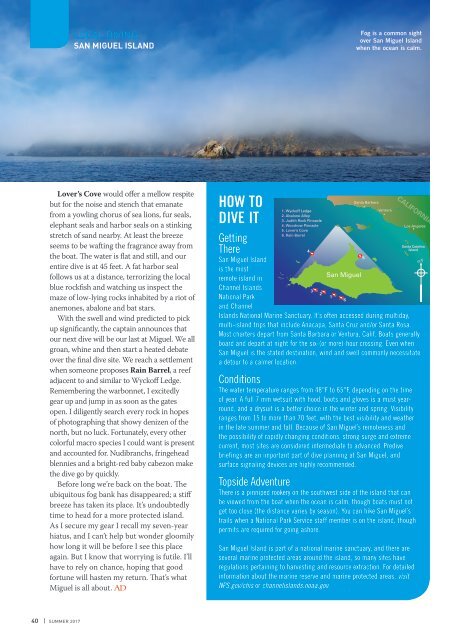AD 2017 Q3
Alert Diver is the dive industry’s leading publication. Featuring DAN’s core content of dive safety, research, education and medical information, each issue is a must-read reference, archived and shared by passionate scuba enthusiasts. In addition, Alert Diver showcases fascinating dive destinations and marine environmental topics through images from the world’s greatest underwater photographers and stories from the most experienced and eloquent dive journalists in the business.
Alert Diver is the dive industry’s leading publication. Featuring DAN’s core content of dive safety, research, education and medical information, each issue is a must-read reference, archived and shared by passionate scuba enthusiasts. In addition, Alert Diver showcases fascinating dive destinations and marine environmental topics through images from the world’s greatest underwater photographers and stories from the most experienced and eloquent dive journalists in the business.
You also want an ePaper? Increase the reach of your titles
YUMPU automatically turns print PDFs into web optimized ePapers that Google loves.
LOCAL DIVING<br />
SAN MIGUEL ISLAND<br />
Fog is a common sight<br />
over San Miguel Island<br />
when the ocean is calm.<br />
Lover’s Cove would offer a mellow respite<br />
but for the noise and stench that emanate<br />
from a yowling chorus of sea lions, fur seals,<br />
elephant seals and harbor seals on a stinking<br />
stretch of sand nearby. At least the breeze<br />
seems to be wafting the fragrance away from<br />
the boat. The water is flat and still, and our<br />
entire dive is at 45 feet. A fat harbor seal<br />
follows us at a distance, terrorizing the local<br />
blue rockfish and watching us inspect the<br />
maze of low-lying rocks inhabited by a riot of<br />
anemones, abalone and bat stars.<br />
With the swell and wind predicted to pick<br />
up significantly, the captain announces that<br />
our next dive will be our last at Miguel. We all<br />
groan, whine and then start a heated debate<br />
over the final dive site. We reach a settlement<br />
when someone proposes Rain Barrel, a reef<br />
adjacent to and similar to Wyckoff Ledge.<br />
Remembering the warbonnet, I excitedly<br />
gear up and jump in as soon as the gates<br />
open. I diligently search every rock in hopes<br />
of photographing that showy denizen of the<br />
north, but no luck. Fortunately, every other<br />
colorful macro species I could want is present<br />
and accounted for. Nudibranchs, fringehead<br />
blennies and a bright-red baby cabezon make<br />
the dive go by quickly.<br />
Before long we’re back on the boat. The<br />
ubiquitous fog bank has disappeared; a stiff<br />
breeze has taken its place. It’s undoubtedly<br />
time to head for a more protected island.<br />
As I secure my gear I recall my seven-year<br />
hiatus, and I can’t help but wonder gloomily<br />
how long it will be before I see this place<br />
again. But I know that worrying is futile. I’ll<br />
have to rely on chance, hoping that good<br />
fortune will hasten my return. That’s what<br />
Miguel is all about. <strong>AD</strong><br />
HOW TO<br />
DIVE IT<br />
Getting<br />
There<br />
San Miguel Island<br />
is the most<br />
remote island in<br />
Channel Islands<br />
National Park<br />
and Channel<br />
1. Wyckoff Ledge<br />
2. Abalone Alley<br />
3. Judith Rock Pinnacle<br />
4. Woodrow Pinnacle<br />
5. Lover’s Cove<br />
6. Rain Barrel<br />
4<br />
3<br />
CALIFORNIA<br />
Santa Catalina<br />
Island<br />
Islands National Marine Sanctuary. It’s often accessed during multiday,<br />
multi-island trips that include Anacapa, Santa Cruz and/or Santa Rosa.<br />
Most charters depart from Santa Barbara or Ventura, Calif. Boats generally<br />
board and depart at night for the six-(or more)-hour crossing. Even when<br />
San Miguel is the stated destination, wind and swell commonly necessitate<br />
a detour to a calmer location.<br />
Conditions<br />
The water temperature ranges from 48°F to 65°F, depending on the time<br />
of year. A full 7 mm wetsuit with hood, boots and gloves is a must yearround,<br />
and a drysuit is a better choice in the winter and spring. Visibility<br />
ranges from 15 to more than 70 feet, with the best visibility and weather<br />
in the late summer and fall. Because of San Miguel’s remoteness and<br />
the possibility of rapidly changing conditions, strong surge and extreme<br />
current, most sites are considered intermediate to advanced. Predive<br />
briefings are an important part of dive planning at San Miguel, and<br />
surface signaling devices are highly recommended.<br />
Topside Adventure<br />
There is a pinniped rookery on the southwest side of the island that can<br />
be viewed from the boat when the ocean is calm, though boats must not<br />
get too close (the distance varies by season). You can hike San Miguel’s<br />
trails when a National Park Service staff member is on the island, though<br />
permits are required for going ashore.<br />
San Miguel Island is part of a national marine sanctuary, and there are<br />
several marine protected areas around the island, so many sites have<br />
regulations pertaining to harvesting and resource extraction. For detailed<br />
information about the marine reserve and marine protected areas, visit<br />
NPS.gov/chis or channelislands.noaa.gov.<br />
2<br />
San Miguel<br />
1<br />
6<br />
Santa Barbara<br />
Ventura<br />
5<br />
Los Angeles<br />
40 | SUMMER <strong>2017</strong>









